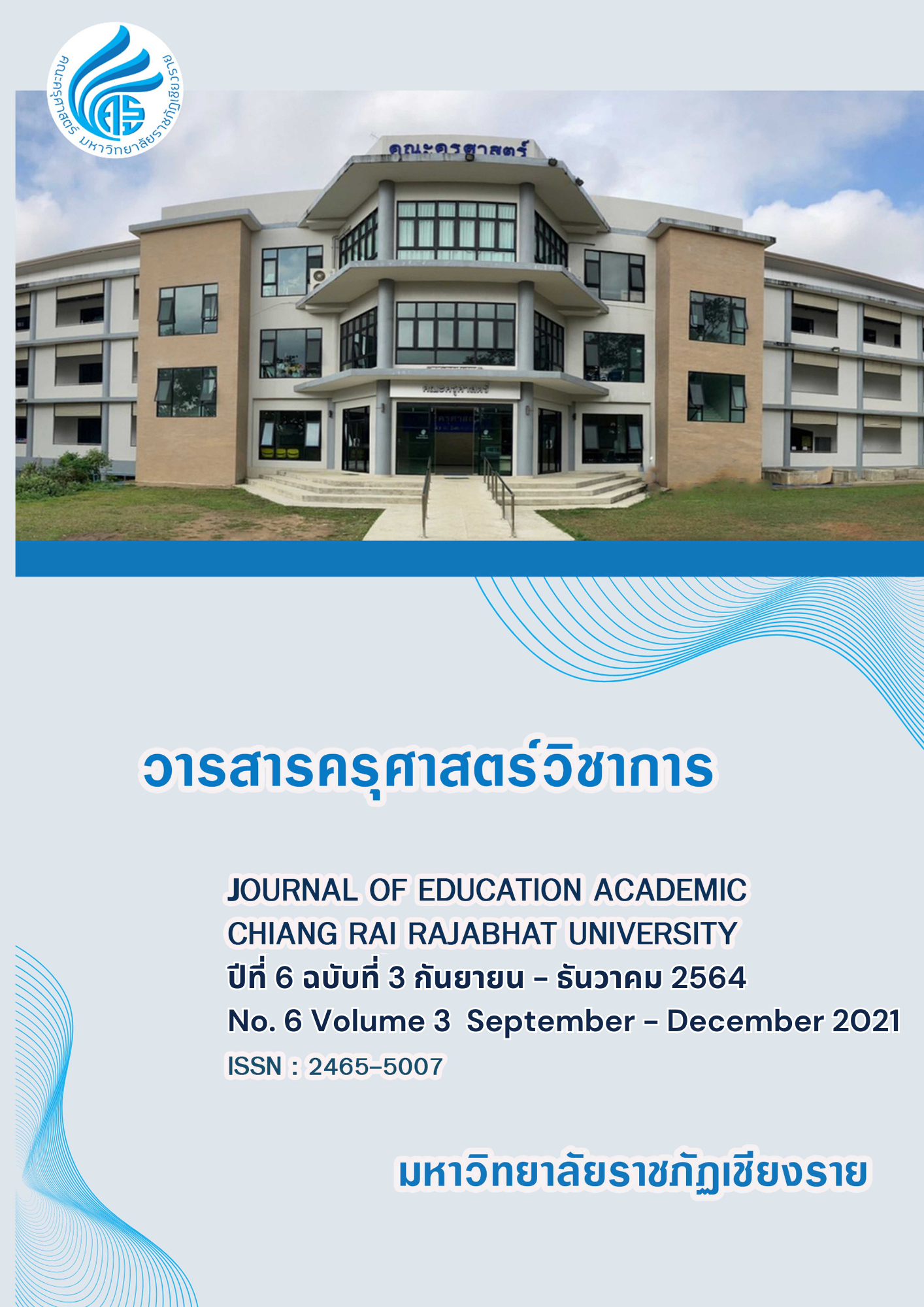The Guidelines for Information Technology System Administration of Rajaprajanugroh 15 School (Wiang kao Saenphu Wittaya Prasart) for Education 4.0
Keywords:
Administration Guidelines, Information Technology, Education 4.0Abstract
The aims of this study were (1) to examine the current information technology system administration of Rajaprajanugroh 15 School (Wiang kao saenphu wittaya prasart) for Education 4.0; (2) to investigate desired condition of information technology system administration of Rajaprajanugroh 15 School (Wiang kao saenphu wittaya prasart) for Education 4.0; (3) to survey causes and factors affecting information technology system administration of Rajaprajanugroh 15 School (Wiang kao saenphu wittaya prasart) for Education 4.0. The mixed-method study employed quantitative and qualitative approaches. The data sources were 95 participants including school director, vice-directors and teachers from Rajaprajanugroh 15 School (Wiang kao saenphu wittaya prasart) The research instruments were questionnaire and focus group discussion. The data was analyzed for mean, standard deivaiton, PNI by content analysis, and the data was presented in narrative and tables. The results showed that:
- 1. The current information technology administration of Rajaprajanugroh 15 School for Education 4.0 comprising 4 stages, in overall, was rated at the high level.
2.The desired circumstance of information technology system administration of Rajaprajanugroh 15 School for Education 4.0 showed that the 4-stage operation, in overall, was rated at the highest level.
- The key factors affecting information technology administration of Rajaprajanugroh 15 School for Education 4.0 revealed that the promoting factors were school administrators supporting operation, giving advice, and offering motivation for implementation of information technology. All units paid attention to implementation of information technology system by showing clear action plan and appointing committees in charge of the system. The de-promoting factors were teachers and educational personnel lacked awareness on the change in implementing information technology system in the administration, inadequate and delayed budget support from government, and lacking monitoring system on information technology system implementation.
- The guidelines for information technology administration of Rajaprajanugroh 15 School for Education 4.0 were proposed. (1) Plan: Should deliver the plan on budget allocation and test information technology system administration by drawing participation from all school staff as well as determine clear meeting calendar. (2) Do: Administration system should raise awareness in implementing information technology system, deliver monitoring process examining the use of information technology in administration by appointing supervising committees, and report the evaluation results to the all teachers and education al personnel in the AAR annual meeting. Instruction: Should develop knowledge and skills on building instructional innovations by deliver workshop for educational staff at the school consistently. Assessment and Evaluation: Should implement information technology system for authentic assessment. The student care system should utilize information technology in authentic assessment. The student care system should create safe zone in relation to student care system. Giving advice: Construct online advice offering service via online platform. (3) Check: Should examine the pre- and post-implementation process on using information technology workshop. 4) Act: Should plan for improving information technology system in order to main the efficiency. Moreover, data collection from partnered schools would stimulate the use of information technology consistently.
References
จำรัส นองมาก. (2545). การศึกษาแบบการคิด (Cognitive Styles) ของนักเรียนในระดับชั้นประถมศึกษาตอนต้น. (ปริญญานิพนธ์การศึกษามหาบัณฑิต). มหาวิทยาลัยศรีนครินทรวิโรฒ. กรุงเทพมหานคร.
จินตนา ลิ้มปี้, ญาณิศา บุญจิตร์, โสภณ เพ็ชรพวง. (2564). การพัฒนาครูผู้สอนในการใช้โปรแกรมประเมินผลทางการเรียนของโรงเรียนบ้านโคกมะม่วง สังกัดสำนักงานเขตพื้นที่การศึกษาประถมศึกษาสุราษฎร์ธานี เขต 3. การค้นคว้าอิสระครุศาสตรมหาบัณฑิต สาขาวิชาการบริหารการศึกษา.
ณัฎฐกานต์ ญาติ และคณะ. (2563). แนวทางการบริหารงานระบบดูแลช่วยเหลือนักเรียนในสถานศึกษาสังกัดสำนักงาน เขตพื้นที่การศึกษาประถมศึกษาจันทบุรี เขต 2. วารสารวิชาการสมาคมสถาบันอุดมศึกษาเอกชนแห่งประเทศไทย (สสอท.). 26(1), หน้า 29-36.
ณัฐิกานต์ ปังศรีวงศ์. (2563). การพัฒนาทักษะด้านการใช้เทคโนโลยีสารสนเทศและการสื่อสารเพื่อการจัดการเรียนรู้ในศตวรรษที่ 21 ของครูโรงเรียนตลาดหนองหวาย สังกัดสำนักงานเขตพื้นที่การศึกษา ประถมศึกษาสุราษฎร์ธานี เขต 2. สาขาการบริหารการศึกษา คณะครุศาสตร์ มหาวิทยาลัยราชภัฏสุราษฎร์ธานี. สุราษฎร์ธานี.
ธนกฤต เสนามาตย์ และ ศิราณี จุโฑปะมา. (2555). สภาพการใช้เทคโนโลยีสารสนเทศในการบริหารงานวิชาการของโรงเรียนสังกัดสำนักงานเขตพื้นที่การศึกษาบุรีรัมย์ เขต 2. การประชุมทางวิชาการเสนอผลงานวิจัยระดับบัณฑิตศึกษา
ภาคตะวันออกเฉียงเหนือ ครั้งที่ 3.
นรเชษฐ์ วันวัฒน์สันติกุล. (2560). การพัฒนาระบบสารสนเทศผลการเรียนออนไลน์กรณีศึกษาโรงเรียนดงมะไฟวิทยาสังกัดสำนักงาน เขตพื้นที่การศึกษา มัธยมศึกษา เขต23. Journal of Graduate School Sakon Nakhon Rajabhat University. 14(67), หน้า 1-7.
ภิญญาพัชญ์ แหวนนาค,และ พรเทพ รู้แผน. (2562). การนำเสนอแนวทางการบริหารเทคโนโลยีสารสนเทศ และการสื่อสารของโรงเรียนมาตรฐานสากลในสังกัดสำนักงานเขตพื้นที่การศึกษามัธยมศึกษา เขต3 จังหวัดพระนครศรีอยุธยา. ARU Research Journal Humanities and Social Sciences. 6(1), หน้า 65-79.
สำนักงานคณะกรรมการการศึกษาขั้นพื้นฐาน. (2552 ข). ระบบการดูแลช่วยเหลือนักเรียน หลักการ แนวคิด และทิศทางในการดำเนินงาน. กรุงเทพมหานคร: สำนักงานฯ.
สำนักงานเลขาธิการสภาการศึกษา. (2560). แผนการศึกษาแห่งชาติ พ.ศ. 2560-2579. กรุงเทพมหานคร: สำนักงานฯ.
อุไร ทองหัวไผ่. (2558). การทดสอบซอฟต์แวร์. Kasem Bundit Journal Volume. 16(2).
Deming, W.Edwards. (1986). Out of the Crisis. MIT Center for Advanced Engineering Study.
Downloads
Published
Issue
Section
License
Copyright (c) 2022 Journal of Education Academic Chiang Rai Rajabhat University

This work is licensed under a Creative Commons Attribution-NonCommercial-NoDerivatives 4.0 International License.






